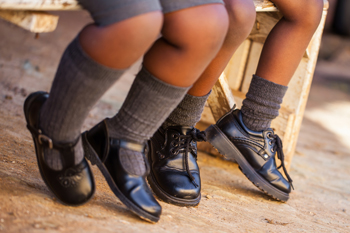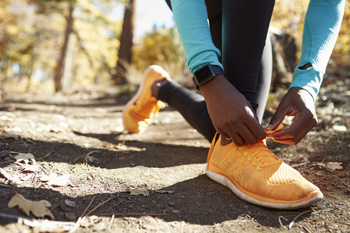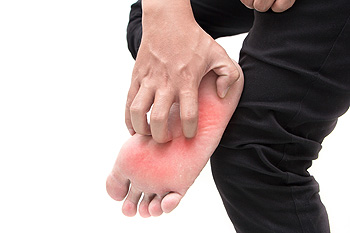 The medical condition that is referred to as a bunion is a permanent deformity of the bones in the big toe. It gradually occurs as a result of genetic factors, or from wearing shoes that do not have adequate room for the toes to move freely in. There are several symptoms that are associated with bunions. These can include corns, calluses, and blisters that can develop on top of the bunion, and the surrounding area may be red and swollen. It may help to purchase larger shoes that can accommodate the bunion, in addition to putting a protective pad over the impacted area. If you notice a developing bunion, it is strongly suggested that you consult with a podiatrist who can provide the correct treatment for you.
The medical condition that is referred to as a bunion is a permanent deformity of the bones in the big toe. It gradually occurs as a result of genetic factors, or from wearing shoes that do not have adequate room for the toes to move freely in. There are several symptoms that are associated with bunions. These can include corns, calluses, and blisters that can develop on top of the bunion, and the surrounding area may be red and swollen. It may help to purchase larger shoes that can accommodate the bunion, in addition to putting a protective pad over the impacted area. If you notice a developing bunion, it is strongly suggested that you consult with a podiatrist who can provide the correct treatment for you.
If you are suffering from bunion pain, contact one of our podiatrists of New York Foot and Ankle. Our doctors can provide the care you need to keep you pain-free and on your feet.
What Is a Bunion?
Bunions are painful bony bumps that usually develop on the inside of the foot at the joint of the big toe. As the deformity increases over time, it may become painful to walk and wear shoes. Women are more likely to exacerbate existing bunions since they often wear tight, narrow shoes that shift their toes together. Bunion pain can be relieved by wearing wider shoes with enough room for the toes.
Causes
- Genetics – some people inherit feet that are more prone to bunion development
- Inflammatory Conditions - rheumatoid arthritis and polio may cause bunion development
Symptoms
- Redness and inflammation
- Pain and tenderness
- Callus or corns on the bump
- Restricted motion in the big toe
In order to diagnose your bunion, your podiatrist may ask about your medical history, symptoms, and general health. Your doctor might also order an x-ray to take a closer look at your feet. Nonsurgical treatment options include orthotics, padding, icing, changes in footwear, and medication. If nonsurgical treatments don’t alleviate your bunion pain, surgery may be necessary.
If you have any questions, please feel free to contact one of our offices located in Franklin Square, Bethpage, Bronx, Brooklyn, and Massapequa, NY . We offer the newest diagnostic and treatment technologies for all your foot care needs.
 Research has indicated babies' feet can become stronger when the toes and feet can move without the restrictions of shoes. The foot muscles can become stronger when the child frequently kicks and wiggles their toes. As children begin to walk, wearing shoes while indoors is discouraged. When walking is done barefoot, the entire foot generally becomes stronger due to the toes grasping the floor. The average age children begin to walk is approximately twelve months. When the first pair of shoes is purchased, it is beneficial to ensure there is adequate room for the toes to move freely in. It is also recommended that your child’s feet are properly measured, as this can help to determine the correct size shoe. For additional information about children's feet and what shoes to purchase, it is suggested that you speak with a podiatrist.
Research has indicated babies' feet can become stronger when the toes and feet can move without the restrictions of shoes. The foot muscles can become stronger when the child frequently kicks and wiggles their toes. As children begin to walk, wearing shoes while indoors is discouraged. When walking is done barefoot, the entire foot generally becomes stronger due to the toes grasping the floor. The average age children begin to walk is approximately twelve months. When the first pair of shoes is purchased, it is beneficial to ensure there is adequate room for the toes to move freely in. It is also recommended that your child’s feet are properly measured, as this can help to determine the correct size shoe. For additional information about children's feet and what shoes to purchase, it is suggested that you speak with a podiatrist.
The health of a child’s feet is vital to their overall well-being. If you have any questions regarding foot health, contact one of our podiatrists of New York Foot and Ankle. Our doctors can provide the care you need to keep you pain-free and on your feet.
Tips for Keeping Children's Feet Healthy
- Make sure their shoes fit properly
- Look for any signs of in-toeing or out-toeing
- Check to see if they have Clubfoot (condition that affects your child’s foot and ankle, twisting the heel and toes inward) which is one of the most common nonmajor birth defects.
- Lightly cover your baby’s feet (Tight covers may keep your baby from moving their feet freely, and could prevent normal development)
- Allow your toddler to go shoeless (Shoes can be restricting for a young child’s foot)
- Cut toenails straight across to avoid ingrown toenails
- Keep your child’s foot clean and dry
- Cover cuts and scrapes. Wash any scratches with soap and water and cover them with a bandage until they’ve healed.
If you have any questions, please feel free to contact one of our offices located in Franklin Square, Bethpage, Bronx, Brooklyn, and Massapequa, NY . We offer the newest diagnostic and treatment technologies for all your foot care needs.
 Research has indicated the importance of wearing shoes that fit correctly while walking and running. There are shoes that are specifically designed for your chosen sport, and it is beneficial to be aware of how the foot strikes the ground. When the proper shoes are worn, the muscles and joints in the feet can function optimally, which can provide a more enjoyable walk or run. Running shoes have more cushioning than walking shoes, and may be lighter in weight. Many running shoes are designed with a mesh material, and this can help the feet to easily sweat as energy is expended. Walking shoes have more of a flexible sole than running shoes, and it may not be necessary to have the same type of stability. If you would like additional information about the differences between walking and running shoes, a podiatrist can provide you with the correct knowledge.
Research has indicated the importance of wearing shoes that fit correctly while walking and running. There are shoes that are specifically designed for your chosen sport, and it is beneficial to be aware of how the foot strikes the ground. When the proper shoes are worn, the muscles and joints in the feet can function optimally, which can provide a more enjoyable walk or run. Running shoes have more cushioning than walking shoes, and may be lighter in weight. Many running shoes are designed with a mesh material, and this can help the feet to easily sweat as energy is expended. Walking shoes have more of a flexible sole than running shoes, and it may not be necessary to have the same type of stability. If you would like additional information about the differences between walking and running shoes, a podiatrist can provide you with the correct knowledge.
For more information about walking shoes versus running shoes, consult with one of our podiatrists from New York Foot and Ankle. Our doctors can measure your feet to determine what your needs are and help you find an appropriate pair of footwear.
Foot Health: The Differences between Walking & Running Shoes
There are great ways to stay in shape: running and walking are two great exercises to a healthy lifestyle. It is important to know that running shoes and walking shoes are not interchangeable. There is a key difference on how the feet hit the ground when someone is running or walking. This is why one should be aware that a shoe is designed differently for each activity.
You may be asking yourself what the real differences are between walking and running shoes and the answers may shock you.
Differences
Walking doesn’t involve as much stress or impact on the feet as running does. However, this doesn’t mean that you should be any less prepared. When you’re walking, you land on your heels and have your foot roll forward. This rolling motion requires additional support to the feet.
Flexibility – Walking shoes are designed to have soft, flexible soles. This allows the walker to push off easily with each step.
If you have any questions, please feel free to contact one of our offices located in Franklin Square, Bethpage, Bronx, Brooklyn, and Massapequa, NY . We offer the newest diagnostic and treatment technologies for all your foot care needs.
 Skin that is red and peeling between the toes can be indicative of a condition that is known as athlete’s foot. It is a fungal infection, and is caused by fungus that lives and thrives in warm and moist environments. These can consist of public swimming pools, locker rooms, and communal showers. Additional symptoms may include severe itchiness, blisters, and the skin may become thick and cracked. Helpful prevention methods can involve wearing appropriate shoes while in these areas, followed by washing and drying the feet thoroughly. Athlete’s feet can cause pain and discomfort. If you think you are afflicted with this ailment, it is strongly suggested that you consult with a podiatrist who can prescribe the necessary medication for an effective treatment.
Skin that is red and peeling between the toes can be indicative of a condition that is known as athlete’s foot. It is a fungal infection, and is caused by fungus that lives and thrives in warm and moist environments. These can consist of public swimming pools, locker rooms, and communal showers. Additional symptoms may include severe itchiness, blisters, and the skin may become thick and cracked. Helpful prevention methods can involve wearing appropriate shoes while in these areas, followed by washing and drying the feet thoroughly. Athlete’s feet can cause pain and discomfort. If you think you are afflicted with this ailment, it is strongly suggested that you consult with a podiatrist who can prescribe the necessary medication for an effective treatment.
Athlete’s foot is an inconvenient condition that can be easily reduced with the proper treatment. If you have any concerns about your feet and ankles, contact one of our podiatrists from New York Foot and Ankle. Our doctors will treat your foot and ankle needs.
Athlete’s Foot: The Sole Story
Athlete's foot, also known as tinea pedis, can be an extremely contagious foot infection. It is commonly contracted in public changing areas and bathrooms, dormitory style living quarters, around locker rooms and public swimming pools, or anywhere your feet often come into contact with other people.
Solutions to Combat Athlete’s Foot
- Hydrate your feet by using lotion
- Exfoliate
- Buff off nails
- Use of anti-fungal products
- Examine your feet and visit your doctor if any suspicious blisters or cuts develop
Athlete’s foot can cause many irritating symptoms such as dry and flaking skin, itching, and redness. Some more severe symptoms can include bleeding and cracked skin, intense itching and burning, and even pain when walking. In the worst cases, Athlete’s foot can cause blistering as well. Speak to your podiatrist for a better understanding of the different causes of Athlete’s foot, as well as help in determining which treatment options are best for you.
If you have any questions please feel free to contact one of our offices located in Franklin Square, Bethpage, Bronx, Brooklyn, and Massapequa, NY . We offer the newest diagnostic and treatment technologies for all your foot and ankle needs.
